Portal:Maps/Selected biography
| This Wikipedia page has been superseded by historical reference. |
| Note: Did you know entries are now being transcluded directly on the main portal page. However, this page should be retained for historical reference. |
Selected biography 1
Portal:Maps/Selected biography/1

Ptolemy was the author of several scientific treatises, three of which have been of continuing importance to later
Selected biography 2
Portal:Maps/Selected biography/2

Su Song was the engineer of a water-driven
Selected biography 3
Portal:Maps/Selected biography/3
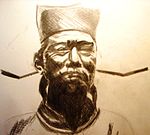
, among many others.
In his
Selected biography 4
Portal:Maps/Selected biography/4

Al-Idrisi's best known work is his map of the world "lawh al-tarsim" (plank of draught), of 1154. He worked on the commentaries and illustrations for eighteen years at the court of King Roger II of Sicily. His map is now known as the 'Tabula Rogeriana', his book as the Geografia. His maps were used extensively during the explorations of the era of the Renaissance like the journeys of Christopher Columbus.
Selected biography 5
Portal:Maps/Selected biography/5

Saint Isidore of Seville (c. 560 – April 4, 636) was Archbishop of Seville for more than three decades and has the reputation of being one of the great scholars of the early Middle Ages. All the later medieval history-writing of Hispania were based on his histories.
Isidore taught in the Etymologiae that the Earth was round. His meaning was ambiguous and some writers think he referred to a disc-shaped Earth; his other writings make it clear, however, that he considered the Earth to be globular. Isidore's disc-shaped analogy continued to be used through the Middle Ages by authors clearly favouring a spherical Earth, e.g. the 9th century bishop Rabanus Maurus who compared the habitable part of the northern hemisphere (Aristotle's northern temperate clime) with a wheel, imagined as a slice of the whole sphere.
Selected biography 6
Portal:Maps/Selected biography/6

Hipparchus was born in Nicaea (now
Selected biography 7
Portal:Maps/Selected biography/7

Eratosthenes studied in Alexandria and claimed to have done so for some years in
Selected biography 8
Portal:Maps/Selected biography/8

Anaximander was one of the earliest Greek thinkers at the start of the
of Miletus as he was sent as a leader to one of its colonies.Selected biography 9
Portal:Maps/Selected biography/9
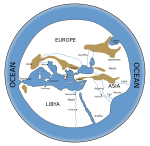
Some have credited Hecataeus with a work entitled Ges Periodos ("Travels round the Earth" or "World Survey"), a point-to-point coastal survey. One on Europe, is essentially a periplus of the Mediterranean, reaching as far north as Scythia. The other book, on Asia, is arranged similarly to the Periplus of the Erythraean Sea of which a version of the 1st century CE survives. The descriptive matter was accompanied by a map, based upon Anaximander’s map of the earth.
Selected biography 10
Portal:Maps/Selected biography/10

For the Literary Society of Iceland, he surveyed the country from 1831 to 1843. The results of his work were published in a
Selected biography 11
Portal:Maps/Selected biography/11

He was nicknamed
Selected biography 12
Portal:Maps/Selected biography/12

Flinders' name is now associated with many geographical features and places in Australia in addition to Flinders Island, in Bass Strait. His proposal for the use of iron bars to be used to compensate for the magnetic deviations caused by iron on board a ship resulted in them being known as Flinders bars
Selected biography 13
Portal:Maps/Selected biography/13

Captain
Cook accurately charted many areas and recorded several islands and coastlines on Europeans' maps for the first time. His achievements can be attributed to a combination of seamanship, superior surveying and cartographic skills, courage in exploring dangerous locations to confirm the facts, an ability to lead men in adverse conditions, and boldness both with regard to the extent of his explorations and his willingness to exceed the instructions given to him by the Admiralty.
Selected biography 14
Portal:Maps/Selected biography/14
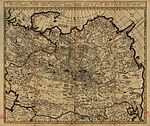
Nicolaes Witsen was the son of Cornelis Jan Witsen, mayor of Amsterdam, head bailiff and administrator of the Dutch West India Company. Witsen published the first map of Siberia, and in 1692 a treatise titled "Noord en Oost Tartaryen", describing Siberia and the surrounding areas.
Selected biography 15
Portal:Maps/Selected biography/15

Beginning as a map-engraver, in 1547 he entered the Antwerp
Selected biography 16
Portal:Maps/Selected biography/16
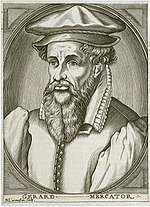
Despite his fame as a cartographer, Mercator's main source of income came through his craftmanship of mathematical instruments. Mercator's own independent map-making only began when he produced a map of Palestine in 1537. Mercator devised a technique to produce globes, celestial as well as terrestrial, by techniques of relative mass production. Twenty-two such pairs of Mercator globes have survived.
Selected biography 17
Portal:Maps/Selected biography/17
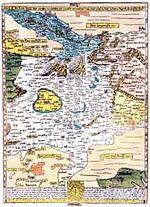
On occasion of the Holy Year 1500, when many pilgrims were expected to go to Rome, he designed his famous "Rom-Weg" map, a 41 x 29 cm wood engraving in stereographic projection of app. scale 1:5,6 mio., the earliest printed road map of central Europe. It is, as all of Etzlaub's maps, "South-up". Distances between cities can be computed by dotted lines, where a one-dot-step means one German Mile (7400m). If the prints were coloured, they show political regions, too.
Selected biography 18
Portal:Maps/Selected biography/18
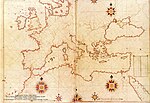
Piri Reis (full name Hadji Muhiddin Piri Ibn Hadji Mehmed) was an Ottoman-Turkish admiral and cartographer born between 1465 and 1470 in Gallipoli on the Aegean coast of Turkey.
He is primarily known today for his maps and charts collected in his Kitab-ı Bahriye (Book of Navigation), a book which contains detailed information on navigation as well as extremely accurate charts describing the important ports and cities of the Mediterranean Sea. He gained fame as a cartographer when a small part of his first world map (prepared in 1513) was discovered in 1929 at Topkapı Palace in Istanbul. The most surprising aspect was the presence of the Americas on an Ottoman map, making it the first Turkish map ever drawn of the Americas.
Selected biography 19
Portal:Maps/Selected biography/19

Johannes Ruysch was an explorer, cartographer, astronomer, manuscript illustrator and painter from the Low Countries who produced a famous map of the world: the second oldest known printed representation of the New World. This Ruysch map was published and widely distributed in 1507.
In old documents Ruysch was sometimes called a Fleming or German, but he was likely born in Utrecht in the current
Selected biography 20
Portal:Maps/Selected biography/20

Amerigo Vespucci (March 9, 1454 - February 22, 1512) was an Italian merchant, explorer and cartographer. He played a senior role in two voyages which explored the east coast of South America between 1499 and 1502. On the second of these voyages he discovered that South America extended much further south than before known by the Europeans. This convinced him that this land was part of a new continent.
Vespucci's voyages became widely known in Europe after two accounts attributed to him were published between 1502 and 1504. In 1507, Martin Waldseemüller produced a world map on which he named the new continent "America" after Vespucci's first name, Amerigo. In an accompanying book, Waldseemüller published one of the Vespucci accounts, which led to criticism that Vespucci was trying to usurp Christopher Columbus's glory.
Selected biography 21
Portal:Maps/Selected biography/21
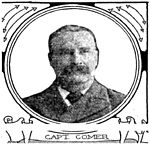
Captain George Comer (April 1858 – 1937) was considered the most famous American whaling captain of Hudson Bay, and the world's foremost authority on Hudson Bay Inuit in the early 20th century.
Comer was a
Selected biography 22
Portal:Maps/Selected biography/22
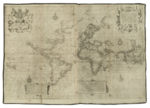
Wright was educated at the
Selected biography 23
Portal:Maps/Selected biography/23
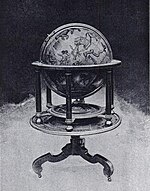
Emery Molyneux was an Elizabethan maker of globes, mathematical instruments and ordnance. His terrestrial and celestial globes, first published in 1592, were the first to be made in England and the first to be made by an Englishman.
Molyneux was known as a
